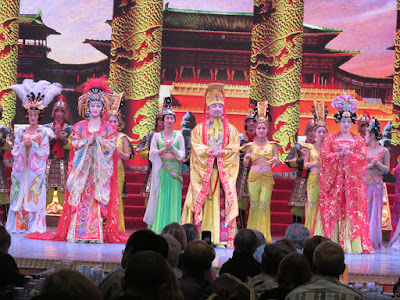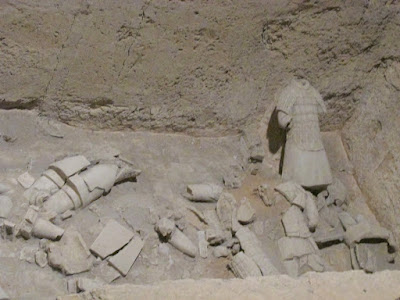We flew to Xi’an in the middle west (the hub on the map in the picture) for a two day visit. Brian told us it is a small city of "only" seven or eight million
and only three ring roads. Our first impression was that it was prettier and
had more trees than Beijing, but it has just as much crowding, litter and poor
areas. Our guide here Tracy (Cui Jing)
was more open to talking about conditions in China than Brian was. He said there are no homeless even though we saw
some. Tracy said yes, many homeless and
beggars. Brian did not know unemployment
rates; she said sometimes high.
Xi’an was the capital of the first
empire, the Qin, 220 BC. The Tang Dynasty, 618-907, was
one of the most dominant and influential in earlier history. Royal and ceremonial buildings were not as
ornate and colorful as in the Ming later in Beijing. Grey, green and red were used more than the
blue and yellow and gold of the Ming.
Xi’an has the only intact city wall
left in China; 90% is original. It is wide
and level on top, making a popular place to walk or ride bikes over its nine
mile rectangular perimeter. When it was
built 600 years ago, 98 ramparts were spaced an arrow shot distance apart.
Four main gates are in the center of the four
walls, each with three gates to get through for defense.
A moat surrounded it, much of which is still
there. A beautiful park now fills the
space between the wall and the most.
Buildings in the old city are limited in height. The high rise buildings are outside the
walls.
One night we had
dumplings—about 15 kinds with vegetables or meats, some twisted into clever
shapes. Since we were mostly a Eugene, Oregon
group, the little yellow ducks were a hit.
Ban Po is an archeological site of
a large village from 6,000 years ago. It
was a matriarchical society near a river, quite advanced in their use of tools
and decorated pottery.
The Small Wild Goose Pagoda was
originally a center for Buddhist monks of the Tang Dyn sect to study and
meditate 600-700 years ago, but it is now a public park. Buddhism was the
official religion and the Emperors’ support gave monks high status. Some went
to India, the source of Buddhism to study for a number of years and then
returned here with many books. So this stone
temple complex included an important Buddhist library.
We had a short but informative
calligraphy lesson that gave a basic understanding of how the Chinese
characters used for writing work. We painted one ourselves. Great fun.
Chinese artwork must have stamps on them. The top one is for happiness and long life,
the second for love, and the bottom one for success.
We had the misfortune of traveling in China during the biggest national holiday, October 1–7. Mao Tse Tung “liberated” China on October 1st, 1949. Many Chinese take a whole week holiday for National Day, so tourist spots are crowded. October 2nd was Terra Cotta Warrior day for us. Normally it has 30,000 to 40,000 people visiting daily. During National Holiday week, 70,000 to 80,000 is typical. The main site there, Pit # 1, was packed. We had to fight full-length body contact layers of people 15 deep in front of the railings around the pits containing the warriors. Many in our group did not get to the front. As we were buffeted around, I thought this is how people can get trampled in a crowd.
Quick history lesson. In the centuries BC, China was a composed of
a number of independent kingdoms. The Qin (pronounced Chin) king conquered all seven large
kingdoms and united them for the first time in 221 BC. He declared himself Qin Shi Huang (First
Emperor of the Qin). This may be where the name China came from. He started building the Great
Wall and the first roads. He standardized
currency, measures, and most importantly language and writing. He also continued his mausoleum, the largest
of any king previous. His brutal wars
and treatment of common people had reduced the population, so instead of
killing all his warriors to guard him in the afterlife, he had artisans build an
army of terra cotta using the local clay which was the best in China. So far 8,000 life-size soldiers, infantry, archers and
officers have been uncovered in three large underground chambers. Most were broken, but archeologists have
restored great numbers and arranged them as they originally were buried. Traces of paint indicate that the warriors probably were fully colored.
We also visited the nearby factory
where official reproductions are created. The legs are solid but the torso is
hollow. It would be too large to dry and
fire without losing shape if solid. The
heads are made separately. The originals were made from coiled pottery and then
shaped. Every head is different,
presumably made to mirror a live warrior.
The originals were signed in inconspicuous places showing that 87 different
craftsmen created them, each with staff of ten or so. The warriors
have a top knot, the officers a square hat, the archers a top knot off to the
side, and the generals two knots.
After our tours much of the day, we
went to a tea house to have a tea demonstration and tasting of a number of
different Chinese teas. Just as we were
seated, the police ordered the building evacuated due to a gas leak. Some people had gone upstairs to the
restroom, so we had a bit of panic before everyone was accounted for and we
left the area. No tea.
Dinner one night was Chinese Hot
Pot. We mixed various ingredients to create our own sauce—sesame oil and paste,
leek paste, soy sauce, garlic, bean curd paste, Chinese barbecue sauce, chopped
scallions and more. Each person had a
pot of boiling water over a small burner to cook her own food from plates on the lazy
susan—bok choy and other greens, raw egg, tofu, crab, noodles and thin sliced
beef and lamb. The sauce made it delicious; the activity and mishaps made it
fun.
Huge pomegranates and persimmons grow
well here and were being sold along the roads everywhere. We wished we could stop the bus and buy some.





















No comments:
Post a Comment